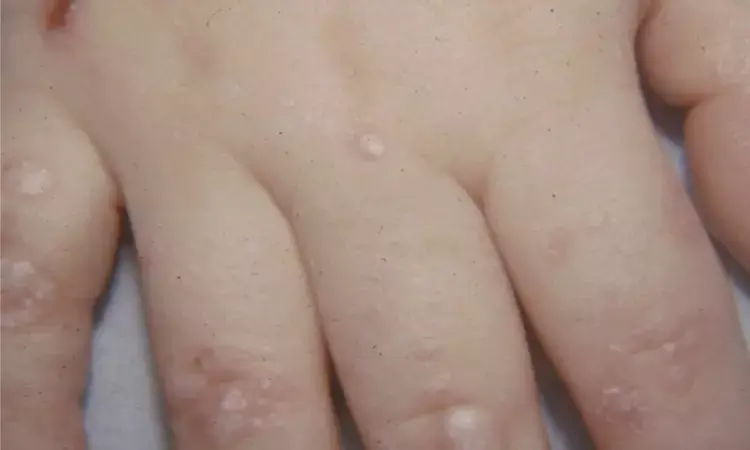- Home
- Medical news & Guidelines
- Anesthesiology
- Cardiology and CTVS
- Critical Care
- Dentistry
- Dermatology
- Diabetes and Endocrinology
- ENT
- Gastroenterology
- Medicine
- Nephrology
- Neurology
- Obstretics-Gynaecology
- Oncology
- Ophthalmology
- Orthopaedics
- Pediatrics-Neonatology
- Psychiatry
- Pulmonology
- Radiology
- Surgery
- Urology
- Laboratory Medicine
- Diet
- Nursing
- Paramedical
- Physiotherapy
- Health news
- Fact Check
- Bone Health Fact Check
- Brain Health Fact Check
- Cancer Related Fact Check
- Child Care Fact Check
- Dental and oral health fact check
- Diabetes and metabolic health fact check
- Diet and Nutrition Fact Check
- Eye and ENT Care Fact Check
- Fitness fact check
- Gut health fact check
- Heart health fact check
- Kidney health fact check
- Medical education fact check
- Men's health fact check
- Respiratory fact check
- Skin and hair care fact check
- Vaccine and Immunization fact check
- Women's health fact check
- AYUSH
- State News
- Andaman and Nicobar Islands
- Andhra Pradesh
- Arunachal Pradesh
- Assam
- Bihar
- Chandigarh
- Chattisgarh
- Dadra and Nagar Haveli
- Daman and Diu
- Delhi
- Goa
- Gujarat
- Haryana
- Himachal Pradesh
- Jammu & Kashmir
- Jharkhand
- Karnataka
- Kerala
- Ladakh
- Lakshadweep
- Madhya Pradesh
- Maharashtra
- Manipur
- Meghalaya
- Mizoram
- Nagaland
- Odisha
- Puducherry
- Punjab
- Rajasthan
- Sikkim
- Tamil Nadu
- Telangana
- Tripura
- Uttar Pradesh
- Uttrakhand
- West Bengal
- Medical Education
- Industry
Topical gene therapy promising for complete wound healing in dystrophic epidermolysis bullosa patients: NEJM

USA: Dystrophic epidermolysis bullosa is a genetic skin disorder that causes the skin to be fragile and blister easily. Mutations in COL7A1 that encodes C7 (type VII collagen) cause the disease.
Beremagene geperpavec (B-VEC) is a topical investigational gene therapy based on herpes simplex virus type 1 (HSV-1) and is designed to restore C7 protein by delivering COL7A1. Findings from a phase 3 trial featured in NEJM (New England Journal of Medicine) showed that the gene therapy led to complete wound healing at 3 and 6 months in dystrophic epidermolysis bullosa patients compared to placebo. The authors observed mild systemic side effects and pruritus in patients treated with the topical administration of B-VEC.
M. Peter Marinkovich from Stanford University School of Medicine in Redwood City, CA, and colleagues conducted a phase 3, double-blind, placebo-controlled, intrapatient randomized trial comprising patients aged six months or above with genetically confirmed dystrophic epidermolysis bullosa.
A primary wound pair was selected for each patient, with the wounds matched according to region, appearance, and size. The scars within each pair were randomly assigned in a ratio of 1:1 to receive weekly B-VEC or placebo for 26 weeks. Complete wound healing with treatment compared to untreated wounds at six months was noted (primary endpoint). Secondary endpoints were complete wound healing at three months and the change from baseline to 22, 24, and 26 weeks in the severity of pain during changes in wound dressing examined with the use of a visual analogue scale that varies from 0 to 10, with higher scores implying more significant pain.
The study led to the following findings:
- In 31 patients, primary wound pairs were exposed to B-VEC and placebo.
- Complete wound healing was seen in 67% of the wounds treated with B-VEC at six months, compared with 22% of those exposed to a placebo.
- Complete wound healing at three months occurred in 71% of the wounds exposed to B-VEC compared to 20% of those exposed to placebo (difference, 51 percentage points).
- With B-VEC, the mean change from baseline to week 22 in pain severity during wound-dressing changes was −0.88 and −0.71 with placebo; similar mean differences were observed at weeks 24 and 26.
- Adverse events included pruritus and chills with B-VEC and placebo.
Topical administration of B-VEC compared to placebo showed more likely complete wound healing at 3 and 6 months in dystrophic epidermolysis bullosa patients. Treatment with B-VEC led to mild systemic side effects and pruritus.
The authors warrant longer and larger trials to determine the side effects and durability of B-VEC for this disease.
Reference:
The study titled "Trial of Beremagene Geperpavec (B-VEC) for Dystrophic Epidermolysis Bullosa," was published in the New England Journal of Medicine.
DOI: 10.1056/NEJMoa2206663
Dr Kamal Kant Kohli-MBBS, DTCD- a chest specialist with more than 30 years of practice and a flair for writing clinical articles, Dr Kamal Kant Kohli joined Medical Dialogues as a Chief Editor of Medical News. Besides writing articles, as an editor, he proofreads and verifies all the medical content published on Medical Dialogues including those coming from journals, studies,medical conferences,guidelines etc. Email: drkohli@medicaldialogues.in. Contact no. 011-43720751


